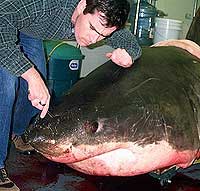 | Nosing Around the Shark's Nose |
 | Nosing Around the Shark's Nose |
|
By Ellen Kuwana Neuroscience for Kids Staff Writer February 23, 2003
|
|
The shark's six senses combine to make sharks great hunters. To track
their prey, sharks find areas of the ocean teeming with fish where waters
of different temperatures meet (called "thermal boundaries"). How do they
sense the water temperature so well? According to physicist Brandon Brown of the University of San Francisco, sharks are "the most temperature-sensitive creatures we know." Dr. Brown has discovered that the gel in those pores create an electrical current in response to differences in water temperatures. These electrical currents in turn cause electrically sensitive nerve cells to fire. This is how the shark detects small changes in water temperature, thus leading it to waters rich in fish. In the lab, Dr. Brown warmed test tubes of the gel. He found that a difference in temperature as small as one degree Celsius resulted in a voltage as large as 300 microvolts. The experiments suggest that the gel could enable the shark to detect water temperature changes as small as 0.001 degrees Celsius. How did Dr. Brown obtain this gel? He is known around the Bay Area coastline for being interested in sharks, so whenever a shark dies at an aquarium or washes up on shore, someone calls him. Getting the gel, it turns out, is easy! Just push down on the snout and the gel oozes from the pores. This Jell-O-like substance is then collected and whisked back to the laboratory. |
 Photo credit: Dr. Douglas Kellogg, University of San Francisco |
| Did you know?
Tagging studies have surprised shark researchers by showing
that great white sharks spend up to 5 months away from shore. Researchers
thought that great whites spent all of their time near shore, in waters
within 30 meters of the surface. The new data suggest that these predators
spend plenty of time 300 to 500 meters down. It makes sense that having
sharp senses would be a big advantage in deeper, murkier waters. |
|
|
References:
|
| GO TO: | Neuroscience In The News | Explore the Nervous System | Table of Contents |
![[email]](./gif/menue.gif) Send E-mail |
 Get Newsletter |
 Search Pages |